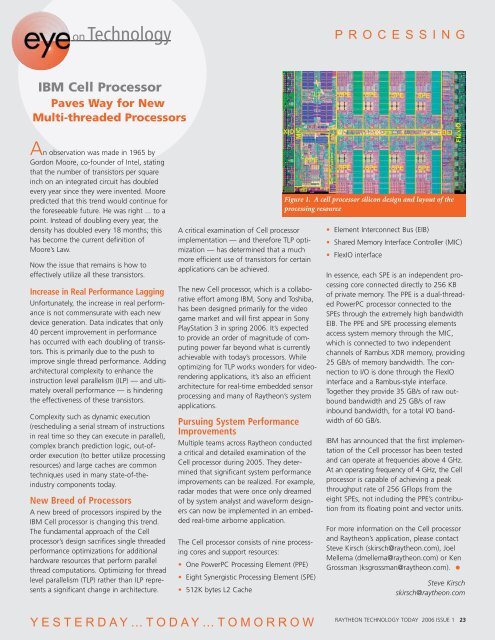ACHIEVING MISSION ASSURANCE - Raytheon
ACHIEVING MISSION ASSURANCE - Raytheon
ACHIEVING MISSION ASSURANCE - Raytheon
You also want an ePaper? Increase the reach of your titles
YUMPU automatically turns print PDFs into web optimized ePapers that Google loves.
onTechnology<br />
IBM Cell Processor<br />
Paves Way for New<br />
Multi-threaded Processors<br />
An observation was made in 1965 by<br />
Gordon Moore, co-founder of Intel, stating<br />
that the number of transistors per square<br />
inch on an integrated circuit has doubled<br />
every year since they were invented. Moore<br />
predicted that this trend would continue for<br />
the foreseeable future. He was right ... to a<br />
point. Instead of doubling every year, the<br />
density has doubled every 18 months; this<br />
has become the current definition of<br />
Moore’s Law.<br />
Now the issue that remains is how to<br />
effectively utilize all these transistors.<br />
Increase in Real Performance Lagging<br />
Unfortunately, the increase in real performance<br />
is not commensurate with each new<br />
device generation. Data indicates that only<br />
40 percent improvement in performance<br />
has occurred with each doubling of transistors.<br />
This is primarily due to the push to<br />
improve single thread performance. Adding<br />
architectural complexity to enhance the<br />
instruction level parallelism (ILP) — and ultimately<br />
overall performance — is hindering<br />
the effectiveness of these transistors.<br />
Complexity such as dynamic execution<br />
(rescheduling a serial stream of instructions<br />
in real time so they can execute in parallel),<br />
complex branch prediction logic, out-oforder<br />
execution (to better utilize processing<br />
resources) and large caches are common<br />
techniques used in many state-of-theindustry<br />
components today.<br />
New Breed of Processors<br />
A new breed of processors inspired by the<br />
IBM Cell processor is changing this trend.<br />
The fundamental approach of the Cell<br />
processor’s design sacrifices single threaded<br />
performance optimizations for additional<br />
hardware resources that perform parallel<br />
thread computations. Optimizing for thread<br />
level parallelism (TLP) rather than ILP represents<br />
a significant change in architecture.<br />
A critical examination of Cell processor<br />
implementation — and therefore TLP optimization<br />
— has determined that a much<br />
more efficient use of transistors for certain<br />
applications can be achieved.<br />
The new Cell processor, which is a collaborative<br />
effort among IBM, Sony and Toshiba,<br />
has been designed primarily for the video<br />
game market and will first appear in Sony<br />
PlayStation 3 in spring 2006. It’s expected<br />
to provide an order of magnitude of computing<br />
power far beyond what is currently<br />
achievable with today’s processors. While<br />
optimizing for TLP works wonders for videorendering<br />
applications, it’s also an efficient<br />
architecture for real-time embedded sensor<br />
processing and many of <strong>Raytheon</strong>’s system<br />
applications.<br />
Pursuing System Performance<br />
Improvements<br />
Multiple teams across <strong>Raytheon</strong> conducted<br />
a critical and detailed examination of the<br />
Cell processor during 2005. They determined<br />
that significant system performance<br />
improvements can be realized. For example,<br />
radar modes that were once only dreamed<br />
of by system analyst and waveform designers<br />
can now be implemented in an embedded<br />
real-time airborne application.<br />
The Cell processor consists of nine processing<br />
cores and support resources:<br />
One PowerPC Processing Element (PPE)<br />
Eight Synergistic Processing Element (SPE)<br />
512K bytes L2 Cache<br />
YESTERDAY…TODAY…TOMORROW<br />
PROCESSING<br />
Figure 1. A cell processor silicon design and layout of the<br />
processing resource<br />
Element Interconnect Bus (EIB)<br />
Shared Memory Interface Controller (MIC)<br />
FlexIO interface<br />
In essence, each SPE is an independent processing<br />
core connected directly to 256 KB<br />
of private memory. The PPE is a dual-threaded<br />
PowerPC processor connected to the<br />
SPEs through the extremely high bandwidth<br />
EIB. The PPE and SPE processing elements<br />
access system memory through the MIC,<br />
which is connected to two independent<br />
channels of Rambus XDR memory, providing<br />
25 GB/s of memory bandwidth. The connection<br />
to I/O is done through the FlexIO<br />
interface and a Rambus-style interface.<br />
Together they provide 35 GB/s of raw outbound<br />
bandwidth and 25 GB/s of raw<br />
inbound bandwidth, for a total I/O bandwidth<br />
of 60 GB/s.<br />
IBM has announced that the first implementation<br />
of the Cell processor has been tested<br />
and can operate at frequencies above 4 GHz.<br />
At an operating frequency of 4 GHz, the Cell<br />
processor is capable of achieving a peak<br />
throughput rate of 256 GFlops from the<br />
eight SPEs, not including the PPE’s contribution<br />
from its floating point and vector units.<br />
For more information on the Cell processor<br />
and <strong>Raytheon</strong>’s application, please contact<br />
Steve Kirsch (skirsch@raytheon.com), Joel<br />
Mellema (dmellema@raytheon.com) or Ken<br />
Grossman )ksgrossman@raytheon.com).<br />
Steve Kirsch<br />
skirsch@raytheon.com<br />
RAYTHEON TECHNOLOGY TODAY 2006 ISSUE 1 23

















